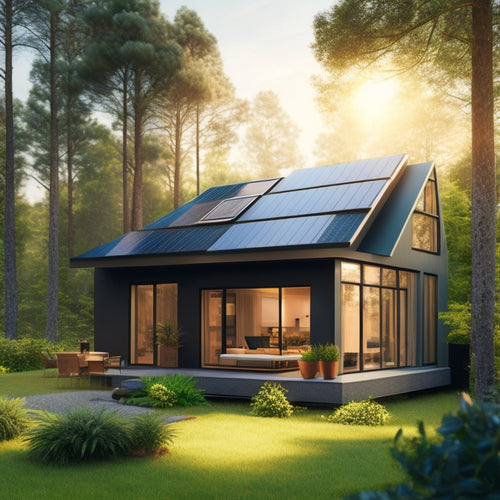
How to Install Rooftop Solar Panels in 3 Steps
Share
You'll start by evaluating your roof's suitability for solar panels, examining its condition, direct sunlight exposure, and potential shading issues. Next, you'll prepare for installation day by reviewing your checklist, clearing the roof of debris, and confirming safety precautions are in place. Finally, you'll mount and connect the panels, securing them to your roof and wiring them together to achieve the desired voltage and current output; with these three steps complete, you'll be well on your way to utilizing renewable energy, and there's still more to investigate to guarantee a successful and efficient installation.
Key Takeaways
- Assess the roof's condition, ensuring it can support solar panels, and inspect for wear, damage, or aging issues.
- Prepare the site by clearing debris, addressing safety hazards, and shutting off electrical power sources before installation.
- Mount and connect solar panels securely, ensuring level and aligned placement, proper wiring connections, and adherence to local electrical codes.
- Consider roof orientation, direct sunlight exposure, and potential shading issues to optimize solar panel performance.
- Implement safety precautions and follow a detailed installation checklist to ensure a smooth and successful installation process.
Assess Your Roof's Suitability
Before investing in rooftop solar panels, assess your roof's suitability to guarantee a successful installation.
You'll want to evaluate your roof's condition to confirm it can support the weight of the solar panels. Check for signs of wear, damage, or aging, such as missing or loose shingles, cracks, or sagging. A roof in poor condition may require repairs or replacement before installation.
Next, consider your roof's solar orientation. Ideally, your roof should receive direct sunlight for most of the day.
Shading from trees, buildings, or other obstructions can greatly impact the performance of your solar panels. If your roof receives partial shade, you may need to adjust the panel layout or consider additional features like panel tilting or tracking systems.
Prepare for Installation Day
You're just a few steps away from utilizing the power of solar energy. Now it's time to prepare for installation day. Before the installation team arrives, verify you've completed the necessary preparations to guarantee a smooth and safe process.
First, review the installation checklist to confirm all necessary materials and equipment are on hand. Verify that your roof is clear of debris and obstructions, and that the installation area is easily accessible.
Take this opportunity to address any potential safety hazards, such as loose roof tiles or overhanging branches. Implement safety precautions to protect yourself, your property, and the installation team. Confirm all electrical power sources are shut off, and consider relocating pets and children to a safe area.
Mount and Connect Panels
With the preparation phase complete, the installation team will now focus on mounting and connecting the rooftop solar panels.
They'll start by securing the mounting hardware to your roof, ensuring it's level and aligned with the roof's pitch. Then, they'll carefully place the solar panels on the mounting hardware, taking care to maintain the recommended panel placement and spacing.
Next, the team will connect the panels in a series to achieve the desired voltage and current output.
They'll make the necessary wiring connections, ensuring they're secure, weather-tight, and meet local electrical codes. The wiring will be routed through the roof's penetrations, and any necessary clamps or clips will be installed to keep the wiring organized and protected.
Frequently Asked Questions
Can I Install Solar Panels on a Metal Roof?
You can install solar panels on a metal roof, leveraging its benefits like durability and water resistance. However, consider specialized installation requirements, such as sealed fasteners and compatible mounting systems, to guarantee a secure and efficient setup.
Will Solar Panels Increase My Property Taxes?
You're wondering if solar panels will increase your property taxes, but don't worry, many states offer property tax exemptions or reassessments that won't hike your bill; in fact, some places even exempt solar panels from assessments, so you'll save on energy and taxes.
Are Solar Panels Covered Under Homeowners' Insurance?
You'll be relieved to know that your solar panels are typically covered under your homeowners' insurance policy, providing financial protection against damage or theft, and further emphasizing the solar panel benefits that come with this smart investment.
Can I Sell Excess Energy Back to the Grid?
You're the captain of your energy ship, steering towards a sustainable future. Yes, you can sell excess energy back to the grid through net metering benefits and energy buyback programs, offsetting your utility bills and maximizing your solar investment.
Do Solar Panels Require Regular Maintenance?
You'll want to guarantee your solar panels operate at peak efficiency; regular cleaning and inspections can enhance energy output, extending their lifespan - typically 25 years or more - and saving you money in the long run.
Related Posts
-

Why You Need a Phone Mount for Navigation
When you're on the road, a reliable phone mount is not just a convenience, it's a safety necessity that helps you mai...
-

Step-by-Step Guide to Converting Your Vehicle to EV
You'll begin by evaluating your vehicle's conversion potential, analyzing its weight, aerodynamics, and powertrain co...
-

Reduce Solar Panel Cost for Your Small Home
By evaluating your energy needs, choosing the right installer, and selecting cost-effective solar panel options, you ...


